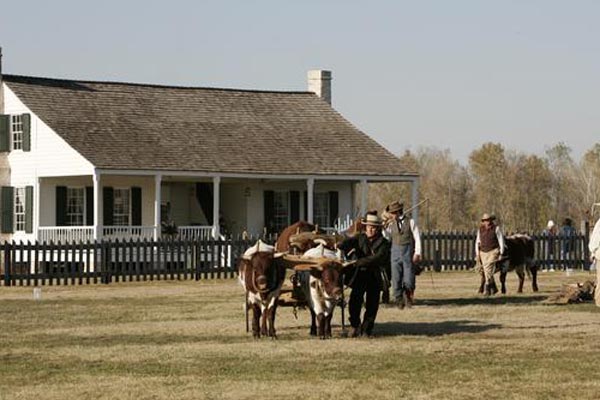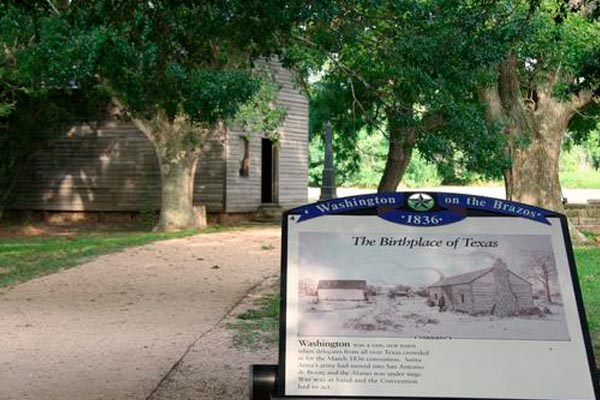Looking for a Quick Getaway?

Destination: Brenham, Texas
Cream of the Crop
By Elaine Robbins
Travel time from:
Austin - 1.75 hours
Brownsville - 6.75 hours
Dallas - 3.75 hours
El Paso - 9.75 hours
Houston - 1.25 hours
San Antonio - 2.75 hours
Lubbock - 8 hours
In addition to tasty ice cream, Brenham brims with history, culture, roses and tiny horses. A trip to the Brenham area has the taste of Blue Bell Creameries new Century Sundae flavor, released this year to commemorate the ice cream makers 100th birthday. Like a bowl of vanilla ice cream with caramel and chocolate sauce topped with maraschino cherries, it evokes a convincing nostalgia for small-town life in a sweeter, more innocent time. In springtime, when Technicolor bluebonnets blanket the roadsides, its easy to be lulled by this pastoral paradise. Cows graze blissfully in rolling green pastures. Newborn calves and foals hover under their mothers legs.
But dont mistake a Brenham nostalgia trip for sleepy. Theres plenty to do in a three-day weekend. You can tour the Blue Bell ice cream factory, see the miniature horses at the Monastery of St. Clare and stop to smell the roses at the Antique Rose Emporium. You can immerse yourself in Texas history at Washington-on-the-Brazos State Historic Site and Barrington Living History Farm. For more of that old-timey atmosphere, drive to the nearby towns of Chappell Hill, Burton and Independence. Theres even something to do at night, from dining and the Unity Theatre downtown to a summer concert series of classical music at the International Festival-Institute at Round Top.
We start our visit at Blue Bell Creameries, which offers a factory tour (weekdays only). Like Brenham itself, Blue Bell is a small-town success story. Although its sold in just 20 percent of the nations stores, Blue Bell is the number-three brand, after Dreyers and Breyers. Sure, Blue Bell has made a few duds over the years the Dill Pickles n Cream must have prompted a run on grocery stores by pregnant women, but the homemade vanilla, cookies and cream and Dutch chocolate have earned it a loyal following.
In the 1900 era there were hundreds of dairy farmers in this area, says Blue Bell public relations manager Bill Weiss. Now there are only two or three in the county. Today the creamery gets its milk from dairy farms within a 200-mile radius. Weiss takes us to an observation area that overlooks a labyrinth of gleaming steel pipes and containers. We see the pasteurizing tank, the flavoring tanks and an area where special ingredients like strawberries and nuts are added. The finished concoction is the consistency of soft custard when its poured into cartons. The cartons go straight into a blast freezer - wind chill factor minus 100 degrees - for eight hours before they get loaded onto trucks.
If my inner child is happy at the ice cream factory, it is delighted when we arrive at the miniature horse farm at the Monastery of St. Clare. The nuns support themselves by breeding American miniatures, and they open their farm to visitors. As we approach the fence, we spot an adorable gray foal prancing in his pasture. We kneel down to his level and call to him, and he ambles over and lets us rub his velvety gray nose. Then he trots back to his mother who herself is less than 3 feet tall at her back. Soon, exhausted with the exuberance of new life, he folds up his legs and falls fast asleep in the grass. American miniatures were once popular as fashionable gifts for children in the courts of Europe. Later they fell out of fashion and, in a Dickensian twist of fate, many ended up working in circuses and in the coal mines of Wales and Appalachia. In the late 1800s, they were rediscovered and selectively bred to their current size. Today, members of this gentle breed are sold as pets, show horses and driving horses.
We head to downtown Brenham to meet up with local doctor and amateur historian Walter (Boy) Hasskarl. At 88, Hasskarl has been around Brenham almost as long as Blue Bell Creamery. We used to see patients in our offices above the pharmacy, he says of his medical practice with his father, Dr. W. F. Hasskarl, and Dr. Thomas Giddings. We never paid rent, because we sent patients downstairs to the pharmacy. Eventually we realized that our heart patients were having trouble climbing the stairs. How did they remedy that problem? They helped Brenham build a modern clinic, one that is serving area residents some 50 years later.
Hasskarl takes us to see the handsome 19th-century buildings that surround the courthouse square and now house shops, restaurants and cafés. At a restaurant called Must Be Heaven, you can pull up a stool at an old-fashioned soda counter. Pointing to one old building, he says, That used to be a candy store. Now its a cutesy store. Outside the Brenham Heritage Museum, he shows us a horse-drawn steam fire engine, one of three left in the country. As early as 1868, Brenham built four huge cisterns under the city streets, a civic achievement that put it ahead of most other Texas towns. The cisterns collected water to be used in fighting fires.
When we admire the Art Moderne entryway of the county courthouse, and Hasskarl shows us a photograph of the old courthouse, a stunning building that was torn down in 1940 in a misguided effort to update the towns image. They didnt consult me about that one bit, he says. Im still mad about that. He hopes that the old Main Street movie theater has a better fate: Hes part of a group thats raising money to rehabilitate the building.
We check into our B&B, then walk a few blocks to dinner at the Ant Street Inn. The inn occupies a turn-of-the-century, two-story commercial building that once housed everything under one roof: a dry goods store, a clothing store, a grocery, a saloon, a beer depot, a printing house and a hay warehouse. Now, like a Victorian dowager a bit down at the heels, the Ant Street Inn has guest rooms upstairs off the main sitting room, which is filled with stained glass lamps and dark polished wood. Downstairs off the main lobby, the restaurant serves steaks, chicken-fried steak and fajitas.
REVOLUTION AND ROSES
We appreciate Brenhams comforts when we visit Washington-on-the-Brazos State Historic Site, where 59 delegates gathered in March 1836 to declare Texas independence from Mexico. Glad to get out of so disgusting a place, wrote Colonel William Fairfax Gray after he left the Washington-on-the-Brazos convention, at which a new constitution was drafted. It is laid out in the woods; about a dozen wretched cabins or shanties constitute the city; not one decent house in it and only one well-defined street, which consists of an opening cut out of the woods. The stumps still standing. A rare place to hold a national convention.
As the delegates met to debate their course of action, a blue norther blew in, and the temperature plunged to 33 degrees. The delegates received news of the tragic Mexican siege of the Alamo, where many of them had relatives lost in the fight. Some wanted to break up the meeting and go join the fight, but Sam Houston urged them to stay and finish their work. Without this, he said, we will be nothing but outlaws. The men signed their Declaration of Independence, modeled on the U.S. document, putting their futures and the lives of their families at risk. Then they drafted a new constitution, and the Republic of Texas was born.
Today no Liberty Bell or colonial city marks the spot of Texas cradle of liberty. In fact, its hard to believe that this quiet, forgotten corner is where delegates gathered to declare its independence. An old wood building, a replica of Independence Hall, where the delegates met, sits under a spreading oak. A path that leads from here down to the Brazos River passes a dazzling field of bluebonnets and magenta phlox.
For a taste of what daily life was like in the Republic of Texas era, the same site houses the Barrington Living History Farm, the home of Anson Jones, the last president of the Republic. Here men and women in period dress tend livestock, cook, build barn buildings - all using mid-19th-century methods. A costumed guide tells us that Anson killed and butchered 25 pigs a year, rubbing them with salt and brown sugar for 29 days to preserve them. Out by the barn, even the pigs are a period breed of Ossabaw Island hogs that the Spanish brought to the Americas some 400 years ago.
Our next stop is Independence, one of the wealthiest communities in the Texas Republic. Today an old schoolhouse and a few ruins under spreading oak and magnolia are all thats left of old Independence. Four brick columns on a breezy spot in a live oak grove mark the spot where the original Baylor University was built in the 1840s.
Down the highway, we found that a perfect way to spend a few hours is to stroll the grounds of the Antique Rose Emporium. The nursery grows hundreds of varieties of antique and old garden roses, some dating back to the 17th and 18th centuries. Dont roses require more water and attention than other flowering plants? we ask gardener P.K. Mathis before deciding whether to buy a rose bush. Modern grafted roses are toy poodles, she says. These old garden roses are Labrador retrievers. Theyre both dogs, but they dont need - or want - the same care.
These old garden roses are more fragrant, too. They stir memories of the sweet-smelling roses my grandfather used to grow. Like recollections of the trip to Brenham, the fragrance will linger long after weve headed home.
Details:
- Washington County Chamber of Commerce, 314 S. Austin St., Brenham, TX 77833 (888-273-6426 or 979-836-3695, www.brenhamtexas.com) The excellent Washington County visitors brochure has a city and county map and describes attractions, accommodations and restaurants.
- Blue Bell Creameries, on Loop 577 off Highway 290 (800-327-8135, www.bluebell.com)
- Washington-on-the-Brazos State Historic Site, (936-878-2214, www.tpwd.state.tx.us/washingtononthebrazos)
- Barrington Living History Farm, on FM 1155, off Highway 105 (936-878-2213, www.tpwd.state.tx.us/barringtonfarm)
- Monastery of St. Clare Miniature Horse Farm, 9300 Highway 105 (979-836-9652, monasteryminiaturehorses.com)
- Antique Rose Emporium, 9300 Lueckemeyer Road, Brenham (800-441-0002, www.weareroses.com)
- International Festival-Institute at Round Top, Highway 237 and Jaster Road, Round Top (979-249-3129, www.festivalhill.org)
- Unity Theatre, 300 Church St., Brenham (979-830-8358, www.unitybrenham.org)
This article appeared in the September 2007 issue of Texas Parks & Wildlife. If you’d like to read more articles like this or subscribe to the magazine, visit www.tpwmagazine.com/.
 Texas Parks and Wildlife Department, 4200 Smith School Road, Austin, TX 78744
Texas Parks and Wildlife Department, 4200 Smith School Road, Austin, TX 78744


